 |
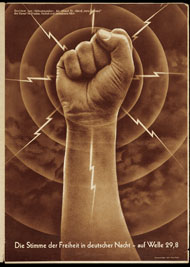
 |
 |
The Voice of Freedom in the German Night on Radio Wave 29.8, 1937
© 2006 Artists Rights Society (ARS), New York / VG Bild-Kunst, Bonn
|
 |
John Heartfield was a pioneer of modern photomontage. Working in Germany and Czechoslovakia between the two world wars, he developed a unique method of appropriating and reusing photographs to powerful political effect.
At a time of great uncertainty, Heartfield's agitated images forecasted and reflected the chaos Germany experienced in the 1920s and '30s as it slipped toward social and political catastrophe. In this climate, communists, Nazis, and other partisans clashed in the press, at the ballot box, and on the streets. The impact of Heartfield's images was so great that they helped transform photomontage into a powerful form of mass communication. Heartfield devised photo-based symbols for the Communist Party of Germany, allowing the organization to compete with the Nazis' swastika. His images of clenched fists, open palms, and raised arms all implied bold action and determination. In the image above, a disembodied fist becomes a radio antenna for a Communist-affiliated station in Czechoslovakia that broadcasted into Fascist Germany.
|
 |
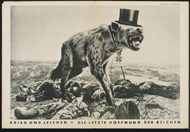
 |
 |
War and Corpses: The Last Hope of the Rich, 1932
© 2006 Artists Rights Society (ARS), New York / VG Bild-Kunst, Bonn
|
 |
 |
Photomontage allowed Heartfield to create loaded and politically contentious images. To compose his works, he chose recognizable press photographs of politicians or events from the mainstream illustrated press. He then disassembled and rearranged these images to radically alter their meaning.
Heartfield's strongest work used variations of scale and stark juxtapositions to activate his already gruesome photo-fragments. The result could have a frightening visual impact, as in this image warning that the country's rearmament exposed a dangerous impulse toward war and its profits.
|
 |
 |
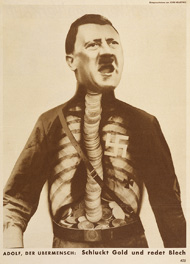
 |
 |
Adolf, the Superman, Swallows Gold and Spouts Tin, 1932
© 2006 Artists Rights Society (ARS), New York / VG Bild-Kunst, Bonn
|
 |
 |
|
 |
|
To create the image at right Heartfield overlaid a widely published photograph of Hitler with a chest X-ray. The caption reads, "Adolf, the superman, swallows gold and spouts tin." Here, Heartfield refers to the large contributions that wealthy industrialists were making to the Nazi Party (National Socialist German Worker's Party) despite its alleged basis in socialism. Heartfield's image reveals the contradictions between Hitler's financial support and his workingman rhetoric.
This and many more of Heartfield's montages appeared in the magazine, Die Arbeiter-Illustrierte Zeitung (Workers' Illustrated Magazine or AIZ). This issue was dedicated to the coming national elections, with images that argued against National Socialism. The artist's contribution is noted with the words "X-ray by John Heartfield" at the top right. This montage made such a strong impact that it was reproduced as a leftist political poster in 1932.
|
 |
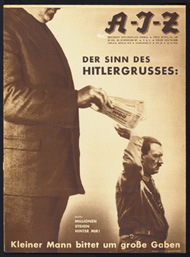
 |
 |
The Meaning of the Hitler Salute: Little Man Asks for Big Gifts, 1932
© 2006 Artists Rights Society (ARS), New York / VG Bild-Kunst, Bonn
|
 |
 |
Heartfield unleashed his sharpest satire on Hitler's Führerkult (cult of the leader), the basis of German Fascism. These montages parody Hitler's most iconic poses, gestures, and symbols to create the impression that one need only to scratch the thin surface of Fascist propaganda to uncover its absurd reality.
In this cover for the AIZ, Heartfield used a difference in scale to dramatize Hitler's relationship to Germany's wealthy and financially supportive industrialists. The leader is seen as a puppet whose now-infamous gesture reads as the acceptance of monetary influence.
|
 |
 |
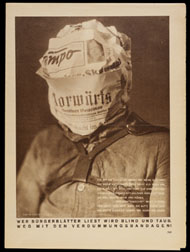
 |
 |
Whoever Reads Bourgeois Newspapers Becomes Blind and Deaf: Away with These Stultifying Bandages!, 1930
© 2006 Artists Rights Society (ARS), New York / VG Bild-Kunst, Bonn
|
 |
 |
|
Heartfield began his regular contributions to the AIZ with this image, at right. Its caption claims that other periodicals misinform their readers.
This was a staged photograph rather than a proper photomontage. To create it, Heartfield covered a mannequin's head with pages from two newspapers, Vorwärts (Forward) and Tempo. As a result, the figure is literally blinded by the prejudices of these newspapers. The blurring at the left reinforces the idea of impaired vision.
|
 |
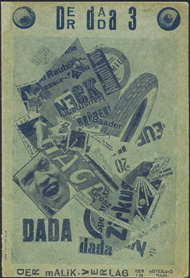
 |
 |
The Tire Travels around the World, 1920
© 2006 Artists Rights Society (ARS), New York / VG Bild-Kunst, Bonn
|
 |
 |
Heartfield's work had its roots in the Dada movement, comprising a group of artists who embraced an aesthetic of chaos to reflect the devestation of World War I Europe.
One of Heartfield's earliest photomontages is this image for the cover of Der Dada, the movement's irregularly published periodical. The montage's seemingly random mix of photo-fragments, text, and graphic components creates a visual tumult meant to reference Germany's particularly turbulent state following the First World War.
|
 |
 |
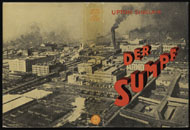
 |
 |
Cover design for Upton Sinclair's Der Sumpf, 1928
© 2006 Artists Rights Society (ARS), New York / VG Bild-Kunst, Bonn
|
 |
One of Heartfield's longest engagements entailed designing book covers for Malik Verlag. This press, run by his brother Wieland Herzfelde, aimed to make leftist books on social issues inexpensively available to the German public. Since many of the authors were little known or foreign, the dust cover was important in attracting attention.
This book is a German translation of California author Upton Sinclair's The Jungle (Der Sumpf in German). The jacket for Der Sumpf was noted for the extended scale of its image, covering the front, back, and spine of the book.
The exhibition is located at the Getty Center, Research Institute Exhibition Gallery.
|
 |